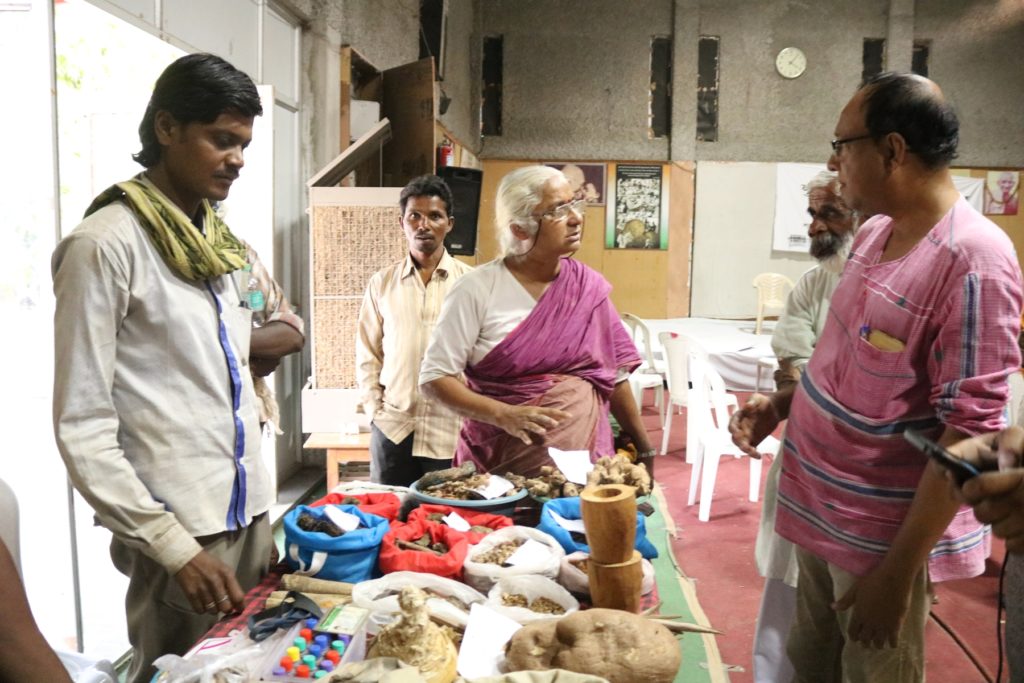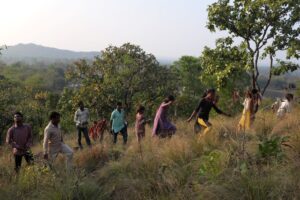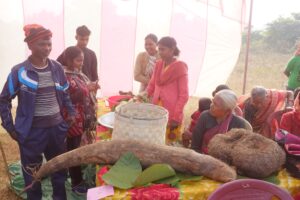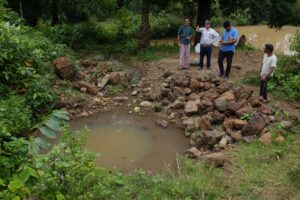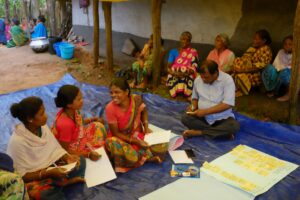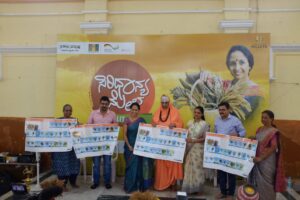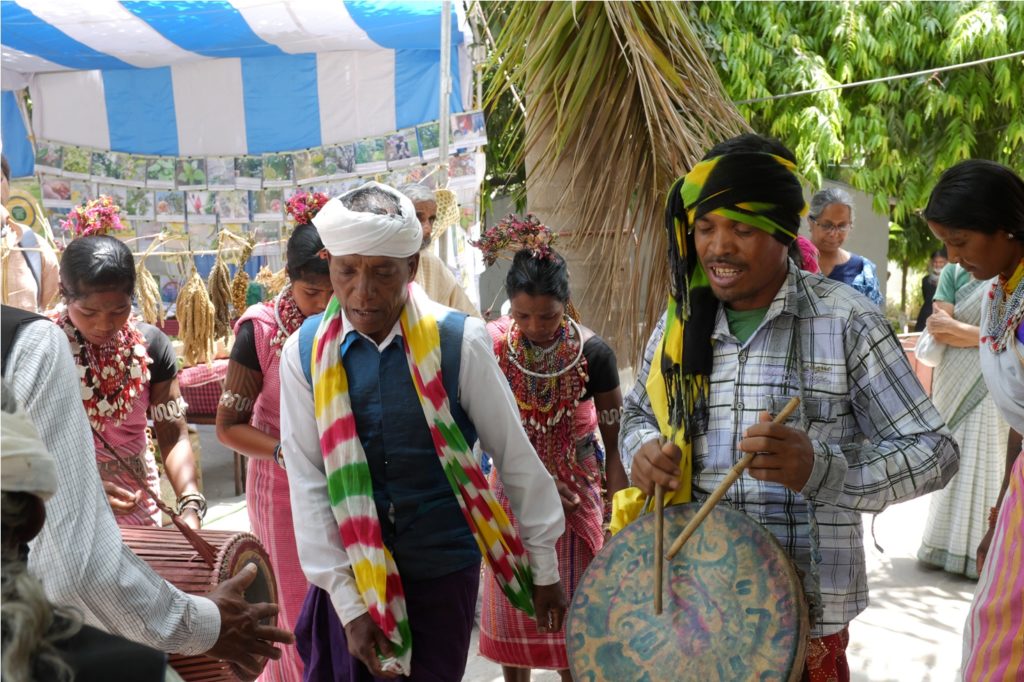
The program commenced with a tradition Baiga dance with the baiga dancers from Dindori escorting the guests and participants into the auditorium to start the program. Rajeev Khedkar and two village elders from the Baiga and Pahari Korwa communities opened the event by lighting diyas on a ceremonial baiga diya holder.
Naresh Biswas of Nirmaan welcomed all guests, participants, staff and villagers to the program. This was followed by an introduction to the Using Diversity Network and the focus of the current UD Project (2017-21) by Rohan Mukerjee. Naresh then invited Tushar Dash, Researcher & Expert on FRA, Odisha; Suprava Patnaik, Professor, Indian Institute of Forest Management, Bhopal; Vijay Zardari, Uttarakhad and Itwari, a Baiga elder; to launch Jungle ke Hakdar a book on the Baigas receiving habitat rights in Dindori District. Tushar Dash emphasized the importance of the Habitat Rights received by the Baigas in the struggle for effective implementation of FRA especially for members of the PVTG community. He commended the efforts to document the struggle for habitat rights in a book which would be an invaluable document for other communities who are still struggling for proper implementation of FRA to learn from. Suprava Patnaik shared experiences from her interactions with the Bhariyas of Patalkot and said that she was so happy to get the opportunity to attend an exhibition on the rich agricultural and forest based traditions of the Bhariyas and other tribal communities from across India. She felt that efforts to help tribal communities to secure rights to their traditional habitat like those documented in ‘Jungle ke Hakdar’ are essential for safeguarding their sustainable natural resource management practices and ensuring their livelihood security as well as food sovereignty and security. Vijay Zardari shared his experiences with the diverse traditional system of Agriculture Baranaja which is practiced in Uttarakhand and also emphasized the need to protect and safeguard such traditional systems through efforts like the struggle for Habitat Rights in Baigachak.
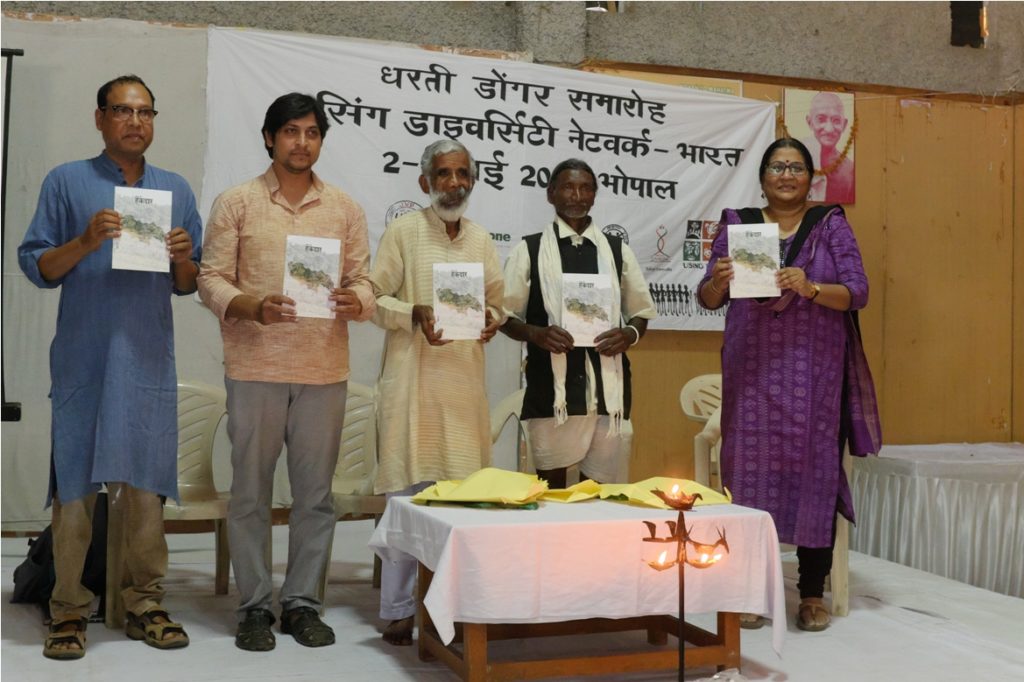
Itwari and Charra Singh from Silpidi village in Dindori District shared their experiences during their struggle for habitat rights and also events after receiving the rights. They highlighted how the journey was far from easy and they faced obstacles, resistance and indifference at every step of the way but they never lost patience in their struggle for their forest rights and used various innovative strategies to smooth over obstacles and garner the support they needed. They conducted a Mela to highlight traditional seeds and wild food diversity of their region for which they invited the District Collector. This mela had a profound impact on the District Collector and she then put pressure on concerned officials to process the Baigas Habitat Rights claims over the forests that make such an invaluable contribution to their food and livelihood security as well as health and nutrition. She steadfastly followed up the claims and helped ensure that the villagers eventually received their habitat rights titles. However, receiving Habitat Rights did not spell an end to the challenges faces by the villagers with respect to their forests. Soon after receiving their rights the Forest Department tried to commence coup cutting in a forest area under their control. The villagers leveraged their Habitat Rights claims to oppose the cutting of trees and reject FD proposals to all coup cutting in return for cash. The post lunch session involved an interactive talk on PVTGs and Habitat Rights by Tushar Das who shared his rich experiences working with PVTG communities and other tribal communities for FRA implementation in Odisha and other parts of India. He focused on CFR and Habitat Rights detailing their importance for PVTG communities and strategies to ensure proper implementation.
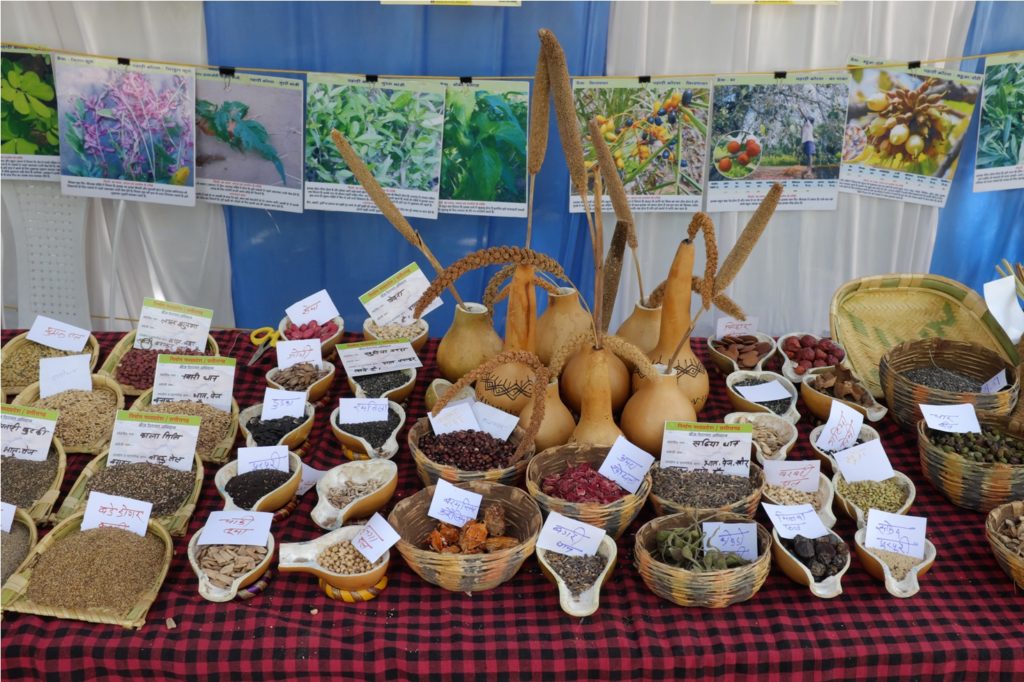
Alongside the book launch and sessions on FRA, PVTG representatives from across India displayed a rich diversity of traditional crops like millets, maize, pulses, kidney beans as well as various uncultivated foods such as tubers, fruits, flowers and seeds that they get from their rich forests. The exhibition on traditional seeds and wild food attracted much local interest and was covered exhaustively in numerous local dailies. This helped lay the platform for highlighting the rich diversity of food crops and uncultivated food that make an invaluable contribution towards the health and nutrition of tribal communities across India but are sadly under serious threat and need a mass movement for their protection and promotion at all levels.
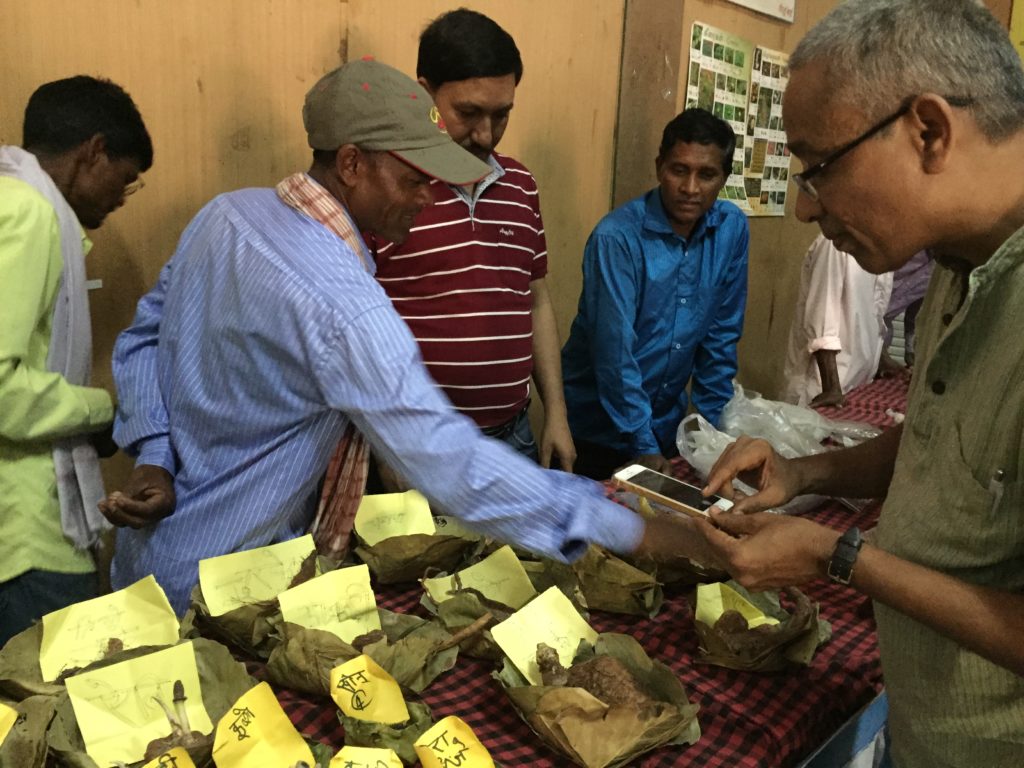
3rd May, 2018, 9:30 am to 1:30 pm – Experience Sharing of Forest Rights and FRA issues – moderated by Tushar Das
The fellows along with farmers from the different project areas shared their experiences, challenges and problems with regards to Forest Rights and FRA implementation with a focus on CFR and habitat rights. Tushar Das, resource person for FRA and Habitat Rights, provided his inputs and insights after each presentation.
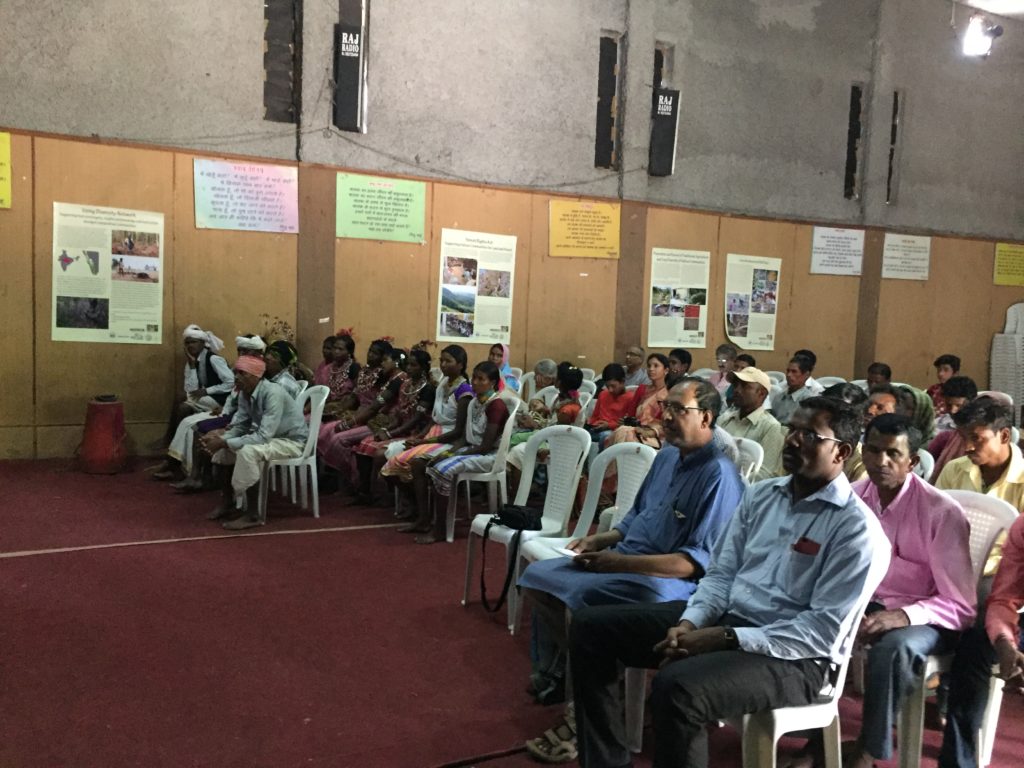
Pahari Korva Villages in Raigad District of Chhattisgarh – Jaykumar Yadav and Bhawaru Hansda
- 6 Villages of Chui Pahar have a majority Pahari Korva population and being isolated from other areas the demographic and geographic characteristics of Chui Pahar make it a potential site for habitat rights claims. However, there has been very limited implementation of FRA in Chui Pahar with only around 18 IFR titles being given till date and no awareness or discussion of CFR claims. Delays in receiving IFR titles despite form submissions are linked to signature of the Panchayat not being done. Villagers reported that no Gram Sabhas have been held with regards to FRA and they have sparse knowledge of FRCs being set up and who are the members.
- One challenge facing Habitat Rights claims for Chui Pahar was that the Chui Pahar area falls under 3 districts of Chhattisgarh – Sarguja, Raigad and Korba; with around 70% falling under Raigad district.
- In villages of Ganeshpur and Amanara the FDW was not signing IFR claims but the villagers have finally managed to receive IFR titles with each claimant getting around 2.5 acres each.
- CFR titles have not been received in Ganeshpur and Amanara despite the Patel in Ganeshpur stating that a CFR application has been submitted but he has lost the receipt. Despite not receiving the CFR titles villagers are now facing less restrictions from the Forest Department who tells them that the forest is theirs.
- Bhawaru also pointed out that some of their project villages are facing major man-elephant conflict and the houses of Barghat village have been destroyed by elephants 3 times in the last 2 years.
Tushar feedback:
- He pointed out that habitat in the Chui Pahar context would mean place of stay, and forest use.
- Since 70% of Chui Pahar falls under Raigad this area needs to be addressed first at the Raigad District Level and then the District Administration could be approached to coordinate with relevant authorities in Korba and Sarguja with regards to the complete Habitat Rights claims of Chui Pahar villagers.
- Tushar also pointed out that initially in Chhattisgarh FRA implementation and addressal of claims was carried out at the Gram Panchayat level and not through Gram Sabhas as laid out in FRA, 2006. This is the reason for Gram Panchayat involvement in IFR and CFR claims in areas like Chui Pahar and other project villages. He feels villagers can now constitute FRCs through their GS and authority for FRA implementation can be vested in the GSs as per FRA.
Bhariya villages of Patalkot, Chhindwara district of M.P. – Suraj Parteti and Gyansa Bharti
- Very limited awareness of FRA in the 12 villages of Patalkot which are home to the Bhariya PVTG community and a small proportion of Gond inhabitants. These 12 villages are spread across 3 Panchayats and are home to 850 households with a population of around 9,000.
- The villagers are not aware of who are the members of FRC committees and have no knowledge of the roles of GS and FRC with regards to FRA implementation.
- Only a few villagers have received IFR titles and there is little knowledge on the process of filing and following up on IFR claims.
- There is no awareness of CFR and not CFR applications have been made across Patalkot.
- There is a threat of relocation by the Forest Department due to a tiger corridor though there have been no official notifications.
- Due to increased prohibitions and action by the Forest Department the villagers have been forest to largely stop their traditional Dahiya cultivation which is a form of shifting cultivation.
Tushar feedback –
- There is a need for a greater awareness and understanding of FRA. He pointed that rotational fallows are allowed under FRA so villagers would be able to carry out Dahiya. Rajeev pointed out that since Dahiya involves burning it is opposed by the Forest Department and there is no clarity regarding burning fallows in FRA.
- With regards to the fear of relocation of villages due to wildlife corridor between Panchmari and Pench Tushar advised that the best strategy for the villagers was to submit claims for CFR at the earliest. As per experiences in Odisha and other parts of India the villages cannot be shifted before settling claims so it is imperative that CFR claims are filed at the earliest. Moreover relocation packages (rumoured to be Rs. 10 lakhs per family) are not applicable till rights are settled and consent sought and received from the Gram Sabha. Also National Commission of Scheduled Tribes can be approached with regards to relocation of villages.
General feedback –
- Naresh Biswas pointed out the CM of MP in a recent visit called for a nodal person per district to address FRA claims and has called for all claims to be submitted and settled promptly till the 30th of May. 2018.
- Participants raised the need for research on fire and controlled fire and its benefits for the environment from Central India. While there has been extensive research on shifting cultivation, its sustainability and environmental impacts in the North East there has been very little research in Central India. 20 years research on shifting cultivation in Thailand and FAO report on shifting cultivation were cited as good sources of reference for benefits of shifting cultivation. The positives and negatives of shifting cultivation were discussed in detail. Naresh pointed out that Bewar fire helps to effectively combat sal borer which is a good example of positive environmental impacts of shifting cultivation. Rohan pointed out that in the past in Garo Hills, Meghalaya shifting cultivation fallow periods used to be 15-20 years then reduced to around 9 years and are now only 3-4 years which is not sustainable and results in reduction of biodiversity and changes in agricultural productivity and diversity as well.
Kamar villages of Gariyaband District, Chhattisgarh – Bholaram Nagesh and Dhansay Sori
- The 10 Kamar villages are close to Udanti Tiger Sanctuary. Majority of IFR titles have been given to the villagers. While some villages report that they have received CFR there is no clarity and the report that all information is with the Gram Panchayat who was instrumental in FRA implementation.
- There is currently fear of the Forest Department among the villagers with regards to carrying out traditional shifting cultivation practices like Bewara (a variety of crops are cultivated), Dahi (rice is cultivated) and Penda (Jhunga is grown). Due to increased restrictions on burning forests for agriculture villagers have reduced traditional agriculture or practice it on the sly in areas where forest department official don’t visit regularly.
Tushar feedback:
- The Kamar villages of this area can claim habitat rights over their forests but there is a need for clarity on whether their area falls under the buffer zone or core zone of Udanti Tiger Sanctuary.
- Tushar has resource material on CFR applications in Sancturary areas which he will share.
Birhor villages of Korba District – Tiharu Birhor
- The Birhors are semi-nomadic and largely dependent on bamboo handicrafts and rope making; and small agriculture near their recent habitations. Earlier they were known as Manji and only now they have been able to assert their Birhor status.
- 10 Birhor villages are being covered under the project.
- Birhor habitations are spread across a large geographical area interspersed by villages and areas of other communities.
- 25% of IFR claims have been settled and remaining are pending with no clarity on progress.
- No CFR claims have been submitted or received and villagers are increasingly being restricted from using forest areas especially for collecting bamboo. They now have to travel 70-80 km to for bamboo collection but still fear being caught by FD officials. As a result they are forced to get bamboo from farmers in exchange for labour.
- FRA implementation is through Gram Panchayat that is why villagers have little clarity of processes and progress of applications. The Gram Sabhas are not well represented in Birhor villages which make it difficult to effectively address forest rights issues; IFR claims and discuss CFR claims.
Tushar feedback:
- Gram Sabhas should assert rights under FRA and with CFRs the Gram Sabhas will have the authority to issue permits for NTFP movement. Also bamboo is now classified as a grass and its collection cannot be prohibited by FD but forest officials take advantage of lack of awareness of the change among villagers to instill fear.
- With regards to potential for Habitat Rights for Birhors of the area Tushar pointed out that it is not necessary for the area to be contiguous for Habitat Rights claims to be made.
- Naresh pointed out that there are a number of government schemes targeted towards PVTG development which the Birhors can access for livelihood development, and growth and promotion of bamboo and bamboo handicrafts in particular.
Paharia villages of Sundar Pahari, Godda District, Jharkhand – Surja Paharia
- 24 Paharia villages still practice Kurwa cultivation. They received titles under land settlement of 1800s and there is no forest department land in their area and they are not facing any interference from FD in using their forest and practicing shifting cultivation.
Tushar feedback:
- Tushar pointed out that the Jharkhand government has been putting forward the perspective that most forest areas have been provided to tribal communities under various British era Land Settlement acts. However, these records are no longer with villagers and they are losing their lands to so-called development activities like mining and FD initiatives like tree planting under CAMPA and other schemes. Settlement forests are increasingly being taken up by the Forest Department. Land banks are also being created by the government under CAMPA which is threatening security of settlement lands.
- Under section 3.1 gh FRA will reconfirm old settlements so Tushar recommended that this be carried out for Paharia villages in order to ensure land and forest security.
Paharia villages of Littipara Block, Pakur District, Jharkhand – Kalida Malto
- 10 Paharia villages and 383 households are being covered under the UD project.
- The villages have both revenue land under the 1872 settlement and forest lands. 4 of the villages have forest land.
- Bridge patta – a lot of tree planting.
- There is a lot of confusion between Van Suraksha Samitis which are still functional and Van Adhikar Samitis.
- The area is under PESA. There is no information on FRA and in particular CFR.
- Van Suraksha Samitis were formed under JFMC by FD and are controlled by FD. Tushar recommended the formation of Van Adhikar Samitis through GSs which would then take over management of JFMC forests.
- Baiga villages of Anupur District, Madhya Pradesh – Lalji Baiga
- Stand off between villagers and FD over Bewar cultivation and 3 villagers arrested recently in this regard. MPs and MLAs approached but no action yet. While for the last ten years there was no action now FD is taking action against the villagers for burning under
- CFR has been applied for but no progress.
Tushar feedback:
- The FD cannot stop them from carrying out Bewar since they have applied for CFR and they should inform FD of this. SC and ST atrocities act can also be cited to prevent excesses by FD officials.
- Southern India and Maharashtra – 4 states and 6 PVTG communities, G. Ramchandaran.
- Tamil Nadu – working with Irula and Kurumba communities. The project is working with 15 Irula and Kurumba villages. Irulas still carry out mixed cropping but over the last 50 years knowledge of mixed agriculture is eroding but due to efforts of Keystone Foundation there is revival being seen.
- Kerala – Pania, Cholanaikan and Katanaikan. The Pania have substantial dependence on plant based food and are recorded to use over 150 plant based foods. Most communities have no land. In 2010-11 IFR were distributed but community is not aware of composition of FRC and who are the members, ITDP – villagers were surprised to see their name. They were in a dilemma whether to claim their rights again but GSs got together and are now in the process of claiming CFRs. These health situation of these communities is extremely poor with high incidence of anemia.
- Karnataka – Jenu Kurumba. They were brought out of the forest and are currently prohibited from entering the forests even for religious purposes. As a consequence they are gradually forgetting their traditional practices particularly with regards to uncultivated food.
- Maharashtra – Working in 10 villages of the Katkari community who are semi-nomadic. They have no land rights and have a remote dependence on forests which are around 20-30 km from their settlements. They tend to visit the forests once every season to meet their needs. They are largely a fishing community and there is a lot of diversity of fish species that they depend on.
4th May 2018, 9:30 am to 12:30 pm – Experience Sharing on Traditional Agricultural Practices – chaired by Vijay Zardari
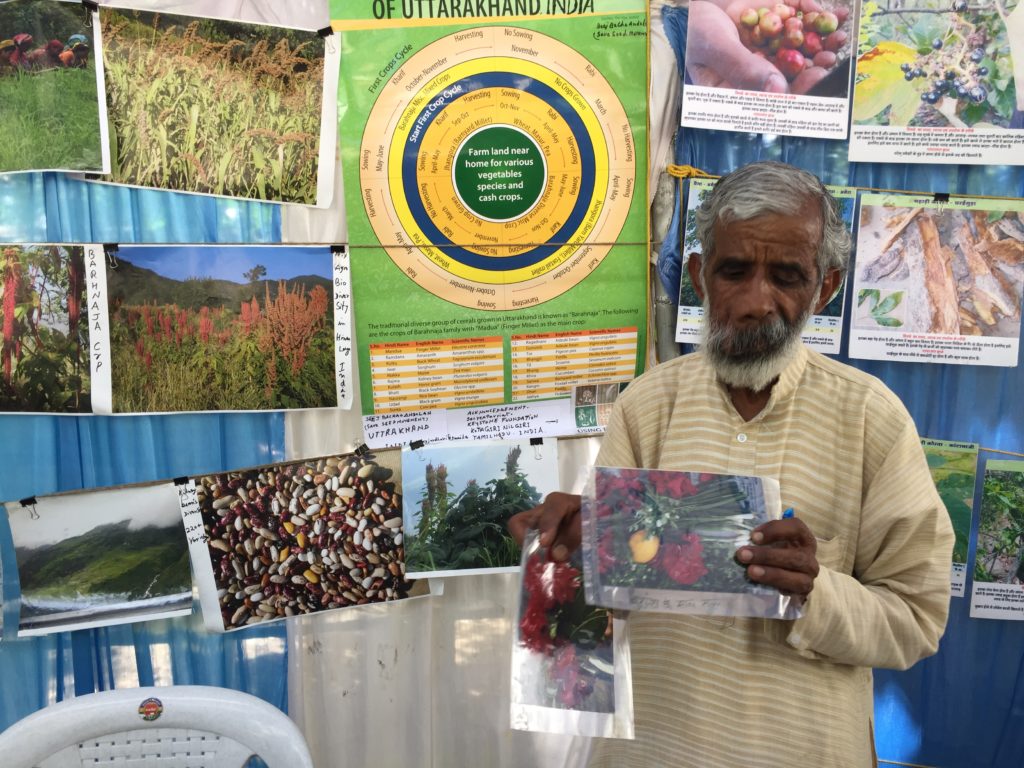
Paharias of Sundar Pahari, Godda District, Jharkhand – Surjo Paharia and farmer participants.
- In August they sow barbatti and harvest in December. If it rains too much it rots or gets insect infestation.
- In May the fields are cleared and burnt for Kurva mixed agriculture. They use 18 inch wood row maker for sowing.
- After 15-20 days they carry out weeking.
- Crop depredation is carried out by wild boar and monkeys and the villages have to guard the field day and night to prevent crop destruction. They use gulel and traps to chase away and catch the animals.
Kamars of Gariyaband District, Chhattisgarh – Bhola Nagesh, Dhansay Sori and farmers.
- In Penda agriculture they clear the field in January and leave the vegetation to dry and burn before planting jhunga in July. After 20-25 days of planting they carry out weeding.
- In Bewar agriculture they grow madia, urad, jhung and bhedra and it lasts for 2-3 years.
Bhariyas of Patlakot, Chhindwara District, Madhya Pradesh – Suraj Parteti, Gyansa Bharti and farmers.
- They plough the good land and also use some chemical fertilizers.
- In rocky areas they grow macca, jhunga and other mixed crops from July to September.
- Earlier they used to do Dahiya cultivation which involved cutting and burning forest areas and several varieties of crops were grown. However, due to increased Forest Department restrictions they have stopped Dahiya and a lot of traditional crops have disappeared from their areas.
- If they have sources of water they grow wheat and channa.
- They would like to grow madia and other millets and would like to receive seeds for cultivation through the UD project.
Pahari Korwas of Raigad District, Chhattisgarh – Jaykumar Yadav, Bhawru Hansda and women farmers.
- Bewra cultivation – male and female cultivate separate fields.
- In Phalgun they cut the forest, in Jeth it is burnt and then they sow bende, kang, sokda, bajra, madia. Higher to lower importance.
- Kurrasu not there now,.
- The cultivate for 2 years then they leave and go to the next land. They have 3 lands.
- Forest Department did not allow cutting of forest so the practice of bewra Now they work in non FD areas.
- In Chui Pahar he found a lot of seeds in bewar that had disappeared from other areas of the Pahari Korwas.
- Difficulties facing millets – no demand as modern people do not want.
Paharias of Littipara Block, Pakur District, Chhattisgarh – Kalidas Malto and farmers.
- June 5 they do agriculture.
- Sarson, Kolath. They can grow wheat, chana, museri if there is water.
- They have 3-4 types of agricultural practices. They gather seed in summer months. They carry out mixed agriculture with plough. Weeding is done by all villagers,
- In some lands they grow til and sarso separately.
- In sloppy land they grow barbatti.
- They don’t use fire for agriculture only for mahua trees.
- Some problems they face are wild of barbatti and flowering getting wilt. They use local tobacco and cow urine as an organic pesticide.
Birhors of Korba District, Chhattisgarh – Tiharur Birhorh and farmers
- They cultivate small plots of land with the use of plough and in addition to rice cultivate juhunga and 4-5 types of crops under mixed cropping.
Interactive Session with Vijay Zardari –
- Shared experiences of the Chipko Andolan which is one of India’s first and most famous community led environmental movements. He described how women hugged the trees to protect them from the workers who had come to carry out coup cutting of the forest.
- Government is promoting harmful chemical based agriculture by free distribution of seeds that require chemical fertilizers and pesticides. As a result people are forgetting their rich traditional seeds. Chemical fertilizers work like alcohol which makes a man happy for a short time but the effect wears of and then more is needs which has long term negative impacts. Similarly chemical fertilizers give greater productivity initially but if their use is stopped the productivity drops drastically and they have to be applied again. But these chemical fertilizers negatively impact the soil ecosystem resulting in an increase in pests which need chemical pesticides. Usage of chemical pesticides results in a variety of diseases among consumers of the produce which then results in greater dependence on allopathic medicines thereby creating a destructive cycle of chemical dependence and reduction in health.
- In opposition to these harmful practices the Beej Bachao Andolan came into being and its objectives are the search for, protection and revival of traditional seed diversity. They currently have over 200 rajma varieties, 350 plus rice varieties, 12 millet varieties and a lot of other crops. Initially forests were the source of seeds for our food crops but now they are no longer found naturally so it is our responsibility to sow and keep the rich diversity of traditional seeds that our ancestors gave us alive for future generations. With increased dependence on limited food items provided through PDS health and nutrition has reduced therefore it is all the more important to protect and revive traditional seeds and crops which were rich in nutrition.
- Just like our tongue need different tastes the land needs different kinds of crops and vegetation to help it maintain its health and vitality. Therefore mixed cropping is essential to ensure soil and ecosystem health. If the same seed are planted in the same land repeatedly they tend to get destroyed so in the past farmers used to exchange seed varieties with each other.
- ‘Seed selection – seeds for future sowing should be selected carefully, thick healthy seeds free of insect infestation should be chosen and stored effectively.
- Millets as a result of being the staple of poor people was referred to as mota anaj and looked down upon as the food of the poor. However, now there is increased awareness of the tremendous health and nutrition benefits of millets which is reflected by the government notifying them as Paustik Anaj.
- Climate Change and Agriculture – Earlier there used to be 6 different seasons in India and they seasons used to occur in a timely manner each year. All this has changed in this generation which seasons no longer having a fixed schedule, rains becoming erratic and irregular. Human activities like increased usage of fossil fuels by automobiles and industries are responsible for the climate change we are facing. In the face of these challenges it is all the more important for farmers to have their own seed banks of traditional seeds instead of being at the mercy of the government for acquiring seeds.
- The government should alter its stance with respect to traditional seeds and agriculture and make efforts to promote and safe guard vital traditional knowledge of seeds and agricultural practices. We all need to work together to ensure that this knowledge reaches the next generation.
4th May 2018, Planning for next 6 months with project fellows – 12:30 pm to 4:00 pm
Community fellows and facilitators of each project areas got together to draft a 6 month activity plan for their respective areas. The activity plans were drawn up as per the following broad heads:
- Documentation activities
- Training activities
- Exhibitions and Melas
- Other activities
They developed plans for each of their areas and the Progamme Coordinators and Director, Keystone Foundation provided feedback on each of the plans.

